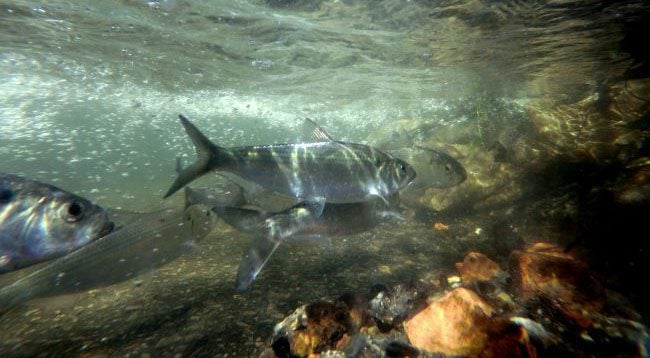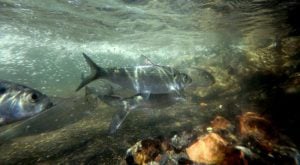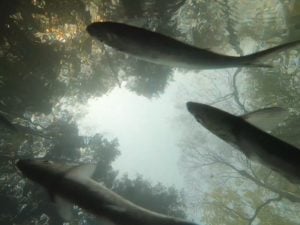Hudson River fish migration: A reason and a season

Herring returning to Wynants Kill after 85 years.
View more images on our Flickr site
Tucked away in the protected reaches of rivers and tributaries, juveniles are allowed to mature with less danger than would be found in the open ocean.
The cold winter winds have mostly settled and hints of the summer sun are starting to warm the sediment-stained waters of the Hudson River as they slide seaward. As you scan the greening hillsides along the Hudson River, you can spot the flowers of the shadbush (Amelanchier canadensis). Those silky white petals herald the coming of warm sunny days and the onset of the growing season.
Shadbush received its name because of a particular fish. The tree blooms when the American shad (Alosa sapidissima), filled with frenetic spawning energy, arrive in the river, fresh from the ocean along with several other species of migratory fish. At this time of year, the Hudson River and its tributaries are alive with migratory fishes as they wend their way upstream in one of the world’s greatest migrations, in silent procession, mostly unseen and largely unknown.
Driven by an imperious urge to spawn and a relentless instinct to home to their natal waters in a repetitive annual cycle, these fishes have timed their vernal migrations and spawning events to a specific range of temperature that ensures the highest survival of their offspring. After spawning is completed, the spent adults leave their fertilized eggs behind as they hurriedly make their way back to the sea, where they will begin to forage again and repair their weakened bodies. In contrast, American eel (Anguilla rostrata) juveniles are here to stay for an extended period of time until they are cued to return to their place of origin, where they themselves will spawn.
Each spring the glowing sun ushers in a new season of growth across the biological spectrum as many of our native plants, birds, mammals and fish species also seek to capitalize on the season’s largesse to recruit a new generation. As the sun’s radiant energy warms the landscape and causes the shadbush berries – also known as service berries – to mature and ripen, billions of juvenile fish hatch after incubating in the sediments for several days. The emerging larvae quickly transform into rapidly growing juveniles and busily consume small aquatic invertebrates, while scouring the quiet waters for other trophic goodies. As the fish grow and mature on the bounty of seasonal abundance, they move downstream to more productive waters, which fosters even greater growth opportunities.
Ultimately they will reach the brackish water and then enter the confluence of river and ocean. The best protection these fish have as they head towards the impetuous ocean is to grow big and strong in the shortest amount of time and aggregate in large silvery schools, where their chances of survival are greatly increased.
When the time and tide is right and the fish have grown large enough, primordial urge drives them across the saline barriers into the open sea. The young-of-year shad and river herring (river herring are a composite species of alewife and blueback herring) leave the protection of their inland nursery grounds for the wild and turbulent ocean, meeting with other schools of forage fishes.
It is a great gamble for a high quality nutritive payoff. Their fusiform shape and forked tail will provide them with sufficient speed and agility to counter the strong ocean currents as they follow the instinctive migration patterns that are hard-wired into their DNA.
Along the way, they will be harassed by a savage and slashing horde of hungry predators looking to fill their gaping mouths. And more menacing to river herring and shad populations these days are the giant purse seines of the mid-water trawl ships that are dragging massive nets through the water in the quest for mackerel, butterfish, longfin squid and sea herring. These nets pull river herring and shad from the sea by the ton because they aggregate with the target species. Even though protections have been placed on shad and river herring stocks, there are few observers on these ships to actually record the incidental catch of particular fishes. It is through voluntary basis the ships’ operators document shad and river herring in bycatch reports. How many of these fish are slaughtered in this fishery largely remains unknown. But in one indication, an entire year’s fishing effort was cut short this past winter in the Mid-Atlantic mid-water trawl fishery after the catch limit (cap) was reached after only two months of fishing.

Alewife return to Wynants Kill after 85 years.
“River herring” is a collective term that includes alewife (Alosa pusedoharengus) and blueback herring (Alosa aestivalis) and is used interchangeably when describing these fish. These two closely related species of fishes are similar in appearance and habitat usage, with slight variation. Alewives generally enter the creeks and tributaries to spawn in mid-April, whereas the bluebacks arrive in May, with timing based upon differences in water temperatures.
Shad are larger cousins of river herring that spawn in the main stem of the Hudson. Collectively, these fishes are ecologically important, functioning as trophic intermediaries in the food chain, embodying the bio-energetic mass of small crustaceans and aquatic invertebrates on the low end of the food web, which they make accessible for the much larger fishes such as tunas, and striped bass (Morone saxatilis) and even dolphins. Interestingly, the ears of river herring are especially tuned to ultra high frequencies to listen to the clicks of approaching dolphins.
“Diadromous” fishes – including American eels, river herring, striped bass (Morone saxatillis) and Atlantic sturgeon (Acipenser oxyrhinchus) – all comprise a suite of migratory fish that are uniquely capable of crossing from saltwater into freshwater and back again.
Adjusting ion concentrations within the somatic and gill tissues as well as the kidneys is necessary when transitioning from saltwater to freshwater and back. It’s no easy task, and only select species can do so. Maintaining salt concentrations within the tissues and kidneys based upon the ambient environment is called osmoregulation. These specially adapted migratory fishes osmoregulate in order to cross the salt barrier, which they do to secure higher survival advantages for their offspring upon hatching. Thus, tucked away in the protected reaches of the rivers and tributaries, juveniles are allowed to mature while being exposed to proportionately less danger than would be found in the open ocean.
The small, transparent juvenile American eels that enter the river are known as glass eels. In contrast to the other diadromous fishes, eels are born in the Sargasso Sea and upon hatching the leaf-shaped larvae known as leptocephali follow the Gulf Stream northward only to detrain from the warm flowing currents by following gyres that lead them inland to the smell of freshwater plumes emanating from coastal rivers, where they transform into glass eels. Upon entering the confluence of a river, glass eels will pick up the tidal pulses coinciding with lunar phases as they make their way upstream. These little eels are also seeking the security of the freshwater habitat and to obtain proper forage in order to pass through several life stages before they develop into sexually mature silver eels, whereupon they will journey back to the Sargassso Sea to spawn and die.
 Why do fish undergo such arduous migrations and cross these salty barriers? Their evolutionary tale is essentially a long game of chance.
Why do fish undergo such arduous migrations and cross these salty barriers? Their evolutionary tale is essentially a long game of chance.
“That which doesn’t kill us makes us stronger” is really the underlying tenet of evolution. If more young are produced than perish, the resulting offspring become sculpted to near perfection in both form and function. Incipient evolutionary patterns become reinforced into the population by higher degrees of of survival. Each fish becomes optimized as a marvel of evolutionary design sculpted by the environment for specific role in the ecosystem. River herring and shad are formed as paragons of athleticism, designed for both speed and long distance travels.
The appearance of diadromy in the bony fishes is a life history strategy that was likely manifested through ongoing evolutionary experimentation over eons of time. Biotic populations of migratory fishes, like all other wild organisms, seek higher degrees of fitness. Those creatures that maintain genetic variation and heritability allow individuals to pass on adaptable traits in response to the demands of the environment. Whereas, many and various forms of life over the geologic procession of time that have not been able to adapt to changing environments have subsequently slipped over the abyss into extinction. Diadromy was a brilliant evolutionary strategy that allowed specially adapted fish to osmoregulate and switch environments, which subsequently provided the species with a greater degree of reproductive fitness than if they remained in their original environment.
Most diadromous fish are anadromous, which means they are born in freshwater and mature in saltwater, and subsequently return to spawn in freshwater. American eels, in contrast, are our only catadromous species – they have a reverse migration pattern; they are born in saltwater and migrate to freshwater to mature. At some point in their lives, catadromous eels are cued to leave their freshwater haunts to migrate back to the Sargasso Sea to spawn. Eels, as opposed to other diadromous fishes in our coastal drainages, are semelparous, which means they spawn once and die.
Diadromy was a brilliant evolutionary strategy until humans arrived on the scene with their increasingly potent forms of technology that harnessed rivers in the form of dams and allowed vessels with sophisticated electronics to locate fish in the wide expanse of the ocean. Consequently, across the globe, diadromous fishes are in deep decline, largely driven by a growing human population and activities that are altering habitats and causing excessive mortality. The sad fact is that these fish alternate habitats, which brings them in conflict with humans, because they require unimpeded access to healthy rivers. Humans have come to densely settle along shorelines since the earliest times. Within the past two centuries, coinciding with the rise of the Industrial Revolution, humans used their ingenuity to harness the power of flowing water by building dams to operate machinery, power mills and generate electricity. Almost every creek and tributary of the Hudson River was dammed for these purposes. To make matters worse, flowing water was treated as an open sewer for human waste and industrial contaminants. Between contraction of spawning grounds and continued overexploitation by humans, many of these migratory fishes have declined to historic population lows. River herring and shad have experienced precipitous population declines from degraded habitat, climate change, invasive species, and ocean bycatch. These fish are retaining a low but tenuous hold on life, and there have been several attempts to place these species on the Endangered Species List. The Atlantic States Marine Fisheries Commission is currently engaged in a population assessment of all three species and will determine the best course of management for these fisheries.
Riverkeeper is currently engaged in a campaign that is advocating for these fishes in many ways, but we are primarily focused on ridding the Hudson River tributaries of obsolete barriers that do little more than block these fishes from their rightful habitat. We are trying to increase critical habitat for both river herring and American eels, which have been declining for the past 30 years. Because river herring and American eels are at historic lows, aggressive action needs to be taken to prevent these ecologically important fishes from decreasing even further.
We’ve taken the first steps. Read about the landmark dam removal at Wynants Kill, a collaboration by Riverkeeper, the City of Troy and the Department of Environmental Conservation. We have also reached agreements with several municipalities to remove several decrepit dams from Hudson River tributaries.
The health of the Hudson River ecosystem is closely tied to the fate of its native fishes. Let’s do everything we can to bring them back from the brink and ensure them a robust future.
If you see these fish in a local creek, give them a sharp salute, for they have undergone heroic efforts to get to our waters, and for their return trip, bless them in the immortal words of Henry David Thoreau, “Keep a stiff fin and stem all the tides thou may’st meet.”
